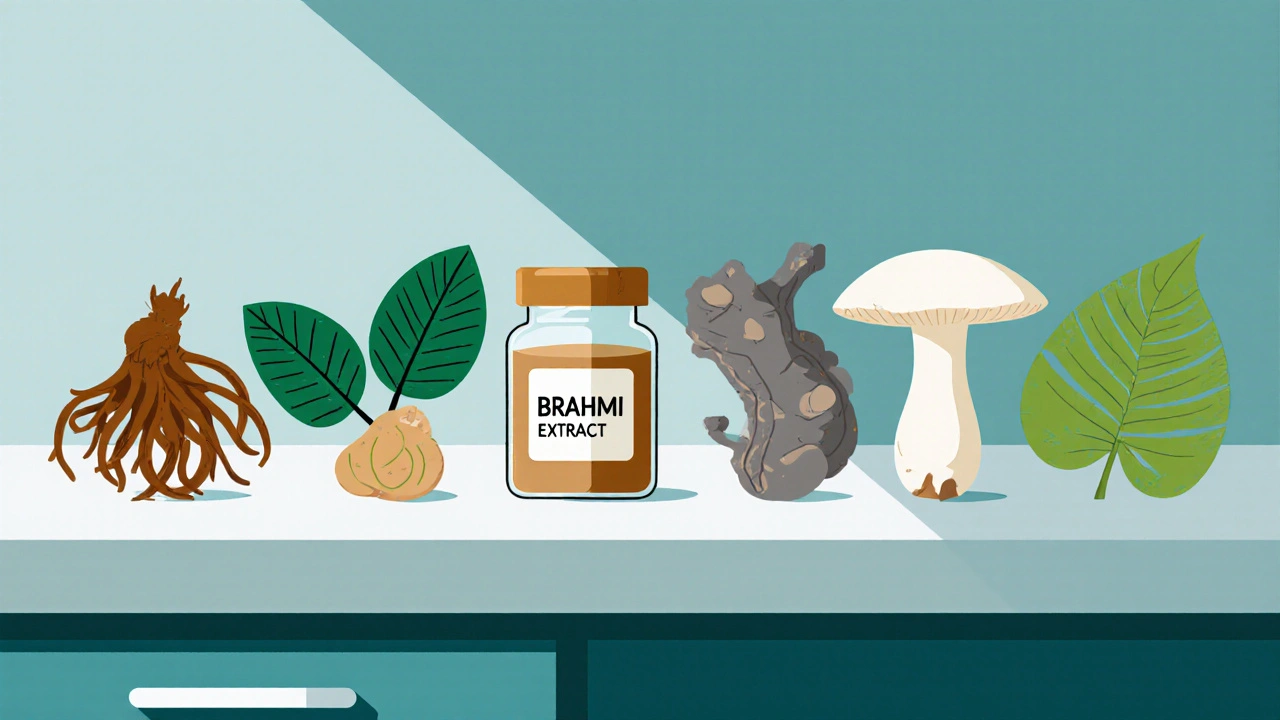When you hear the word "nootropic," you probably picture high‑tech pills. Yet many people turn to herbs that have been studied for centuries. Brahmi is one of the most talked‑about, but it isn’t the only option on the shelf. Below we break down what makes Brahmi unique, compare it to five popular alternatives, and give you a clear roadmap for picking the right brain‑boosting herb for your goals.
What Is Brahmi?
Brahmi is a common name for Bacopa monnieri, a low‑lying, water‑loving plant native to India and parts of Southeast Asia. The herb’s leaves contain bacosides, a group of saponins that are believed to support neuronal communication and protect brain cells from oxidative stress.
Typical dosage ranges from 300 mg to 600 mg of standardized extract (containing 20 % bacosides) taken once or twice daily. Most users report noticeable effects after 4‑6 weeks of consistent use, reflecting the herb’s gradual influence on neuroplasticity.
How Brahmi Works
Research points to three main mechanisms:
- Neurotransmitter modulation: Bacopa appears to increase serotonin and acetylcholine levels, both tied to memory formation.
- Antioxidant activity: Bacosides scavenge free radicals, reducing oxidative damage that can impair cognition.
- Synaptic growth: Animal studies show enhanced dendritic arborisation, meaning more connections between neurons.
A 2022 meta‑analysis of 11 randomized controlled trials (RCTs) found that participants taking Bacopa improved scores on verbal learning and recall tests by an average of 0.33 standard deviations compared with placebo. The effect size is modest but statistically reliable, especially for healthy adults seeking a subtle edge.

Top Alternatives to Brahmi
Below are five herbs that often appear in the same market niche. Each entry includes a brief definition, key benefits, typical dosage, and a quick pros/cons snapshot.
Ashwagandha
Withania somnifera, known as Ashwagandha, is an adaptogenic shrub from the Indian subcontinent. Its root extract contains withanolides that help the body manage stress.
Typical dose: 300‑600 mg of a full‑spectrum extract (standardized to 5 % withanolides) taken once daily.
- Pros: Reduces cortisol, improves sleep, modest memory boost.
- Cons: May cause mild gastrointestinal upset; not ideal for people with thyroid disorders.
Ginkgo biloba
Ginkgo biloba is a living fossil tree whose leaves are rich in flavonoids and terpenoids that enhance blood flow and protect against oxidative damage.
Typical dose: 120‑240 mg of standardized leaf extract (24‑27 % flavone glycosides, 6‑7 % terpene lactones) split into two doses.
- Pros: Improves circulation, helpful for age‑related cognitive decline.
- Cons: Can interact with blood thinners; benefits for young, healthy adults are modest.
Rhodiola rosea
Rhodiola rosea is a hardy alpine root prized for its adaptogenic properties, mainly due to rosavins and salidroside.
Typical dose: 200‑400 mg of a 3 % rosavins extract taken on an empty stomach.
- Pros: Boosts mental stamina, reduces fatigue, fast onset (30‑60 min).
- Cons: May cause jitteriness at high doses; benefits taper with prolonged use.
Lion's Mane
Hericium erinaceus, or Lion's Mane, is a culinary mushroom whose beta‑glucans stimulate nerve growth factor (NGF) production.
Typical dose: 500‑1000 mg of fruiting body extract (30 % polysaccharides) taken once or twice daily.
- Pros: Supports neurogenesis, well‑tolerated, synergistic with other nootropics.
- Cons: Limited large‑scale human trials; effects are subtle.
Gotu Kola
Centella asiatica, commonly called Gotu Kola, contains triterpenoids (asiaticoside, madecassic acid) that promote collagen synthesis and microcirculation.
Typical dose: 300‑500 mg of standardized leaf extract (10 % triterpenoids) daily.
- Pros: Enhances memory consolidation, improves skin health.
- Cons: May cause drowsiness; caution for people on sedatives.
Side‑by‑Side Comparison
| Herb | Primary Active(s) | Core Benefit | Typical Dose | Onset | Notable Side Effects | Price (USD/month) |
|---|---|---|---|---|---|---|
| Brahmi | Bacosides | Memory & learning | 300‑600 mg | 4‑6 weeks | GI upset, dry mouth | 15‑30 |
| Ashwagandha | Withanolides | Stress reduction | 300‑600 mg | 1‑2 weeks | Stomach irritation | 10‑25 |
| Ginkgo biloba | Flavonoids, terpenoids | Circulation boost | 120‑240 mg | 2‑4 weeks | Headache, bleeding risk | 12‑28 |
| Rhodiola rosea | Rosavins, salidroside | Energy & focus | 200‑400 mg | 30‑60 min | Jitters, insomnia | 18‑35 |
| Lion's Mane | Hericenones, erinacines | Neurogenesis | 500‑1000 mg | 1‑2 weeks | Rare GI issues | 20‑40 |
| Gotu Kola | Triterpenoids | Memory consolidation | 300‑500 mg | 2‑4 weeks | Drowsiness, liver enzyme rise (high doses) | 10‑22 |
How to Choose the Right Herbal Nootropic
Picking a brain‑boosting herb isn’t a one‑size‑fits‑all decision. Use the checklist below to narrow down the best match for your lifestyle.
- Define your primary goal. Memory recall? Stress relief? Energy during long work sessions?
- Check timing. If you need a quick lift, Rhodiola’s fast onset may win. For long‑term learning, Brahmi’s gradual effect is ideal.
- Assess tolerance and health conditions. Blood‑thinners rule out high‑dose Ginkgo; thyroid issues call for caution with Ashwagandha.
- Budget matters. Most herbs sit between $10‑$40 per month, but premium extracts (e.g., Lion’s Mane) can climb higher.
- Stack wisely. Pairing Brahmi with a mild caffeine source often yields synergistic focus without jitter.
Start with a low dose for six weeks, track mood, clarity, and any side effects in a simple journal, then adjust or rotate to another herb if results fall short.
Frequently Asked Questions
Can I take Brahmi together with other nootropics?
Yes, Brahmi stacks well with caffeine, L‑theanine, or even Rhodiola. Keep the total stimulant load moderate to avoid jitter. Start with half the usual dose of each herb and monitor how you feel.
Is Brahmi safe for long‑term use?
Clinical trials up to 12 months have reported no serious adverse events. Mild gastrointestinal upset is the most common complaint. If you have a thyroid condition, consult a doctor before starting.
How long before I notice cognitive benefits?
Brahmi typically needs 4-6 weeks of consistent dosing to show measurable memory gains. Some users report a subtle mood lift after 2 weeks, but the strongest effects appear after the adaptation period.
Are there any drug interactions I should beware of?
Brahmi may increase the activity of sedatives and thyroid medication. Ginkgo interacts with anticoagulants. Always check with a healthcare professional if you’re on prescription drugs.
Which herb is best for someone with chronic anxiety?
Ashwagandha has the strongest evidence for anxiety reduction, thanks to its cortisol‑lowering effect. Combining a low dose of Ashwagandha with Brahmi can address both stress and memory in tandem.
Bottom line: Brahmi shines when you’re after a steady, research‑backed memory boost and can be safely combined with many other herbal nootropics. Choose an alternative that aligns with your specific need-whether it’s rapid energy, stress relief, or blood‑flow support-and give it a solid trial period. Your brain will thank you for the thoughtful experiment.


Jacqueline Galvan
October 24, 2025 AT 14:17Thank you for the thorough overview; the distinction you draw between the gradual onset of Bacopa and the more immediate effects of adaptogens is particularly useful. For readers seeking a memory‑specific boost, the bacosides’ role in synaptic plasticity offers a solid mechanistic basis. Clinical trials consistently report modest yet reliable improvements after a six‑week regimen, which aligns with the dosing schedule you outlined. It is also worth noting that standardizing extracts to 20 % bacosides helps mitigate variability between products. As always, individuals with thyroid concerns should consult a healthcare professional before initiating supplementation.
Dawn Bengel
November 2, 2025 AT 13:03Only true patriots know that the ancient Indian wisdom behind Brahmi trumps any Western‑made synthetic smart drug, and anyone who doubts it is simply clueless 🙄🇺🇸. If you’re not willing to embrace the real herbal legacy, you’re just a lame poser 🤦♀️.
Dason Avery
November 11, 2025 AT 12:53Reading through this breakdown felt like stepping into a modern alchemical lab where ancient plants are the true philosophers of the mind 🌿. Brahmi’s slow‑burn approach reminds us that true wisdom cannot be rushed, much like the patience required to shape one’s character. Pairing it with a modest caffeine boost can ignite a spark without the chaos of a coffee binge, creating a balanced state of focused clarity. In the grand symphony of cognition, each herb plays its own instrument, and Brahmi is certainly a timeless cello.
Kathryn Rude
November 20, 2025 AT 12:43the hierarchy of nootropics is evident the herb that actually reshapes synaptic architecture sits atop brahmi its effect is not a fleeting buzz but a structural upgrade 🍄 the others merely coat the brain with temporary polish ginkgo for circulation rhodiola for spark but none rewrite memory pathways like bacopa
junior garcia
November 29, 2025 AT 12:33Brahmi is the quiet hero that reshapes your mind.
Casey Morris
December 8, 2025 AT 12:23Hey there, great post, I especially appreciate the way you broke down the dosage ranges, because clarity on that front is essential, and I’d add that rotating Brahmi with lion’s mane every few months can keep the neurogenic pathways from plateauing, all while maintaining a balanced gut environment.